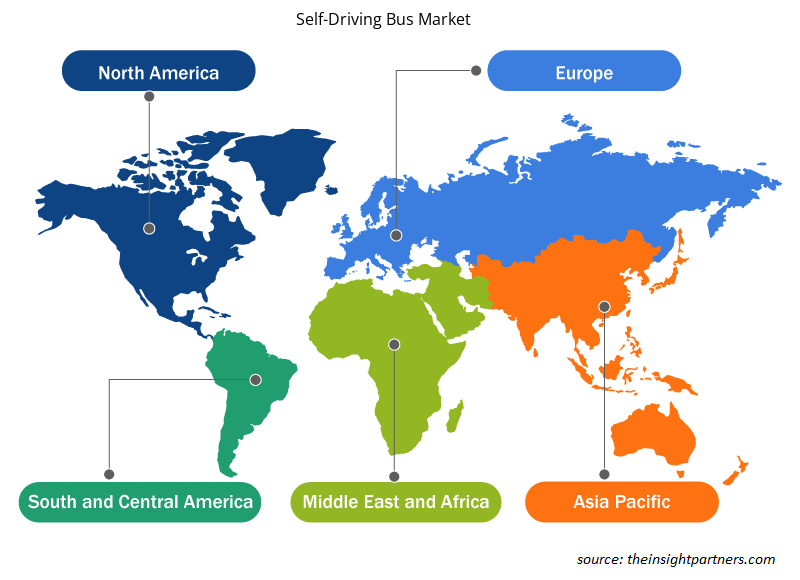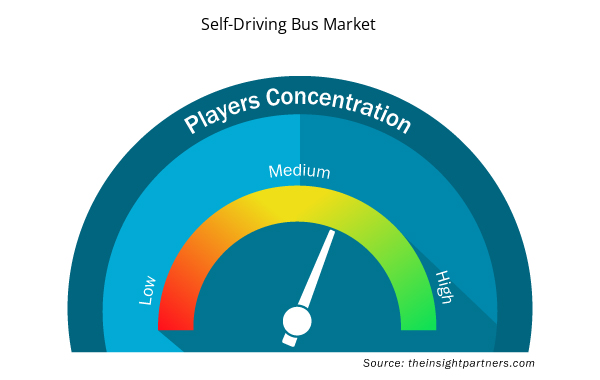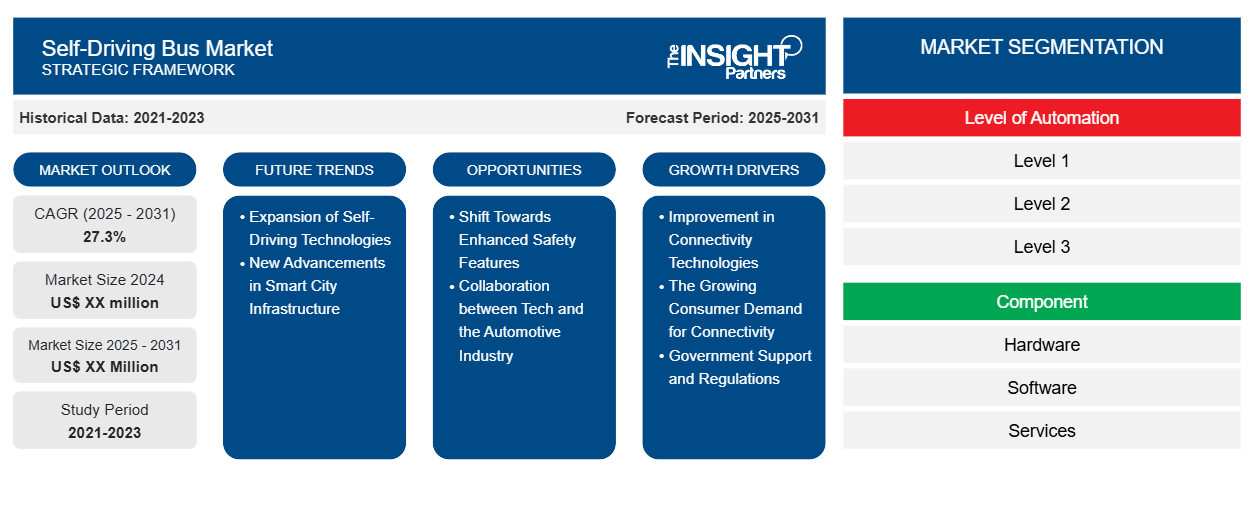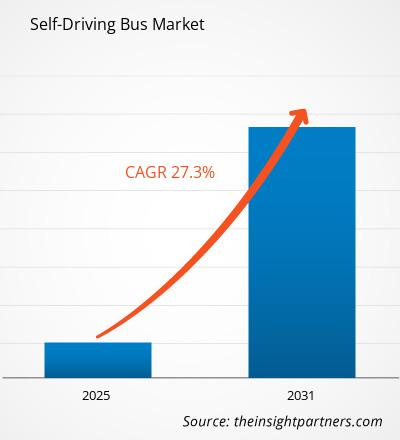Si prevede che il mercato degli autobus a guida autonoma registrerà un CAGR del 27,3% dal 2023 al 2031, con una dimensione di mercato in espansione da XX milioni di dollari nel 2023 a XX milioni di dollari entro il 2031.
Il report è segmentato per Livello di automazione (Livello 1, Livello 2, Livello 3, Livello 4, Livello 5); Componente (Hardware, Software, Servizi). L'analisi globale è ulteriormente suddivisa a livello regionale e nei principali paesi. Il report offre il valore in USD per l'analisi e i segmenti di cui sopra.
Scopo del rapporto
Il report Self-Driving Bus Market di The Insight Partners mira a descrivere il panorama attuale e la crescita futura, i principali fattori trainanti, le sfide e le opportunità. Ciò fornirà spunti a vari stakeholder aziendali, come:
- Fornitori/produttori di tecnologia: per comprendere le dinamiche di mercato in evoluzione e conoscere le potenziali opportunità di crescita, consentendo loro di prendere decisioni strategiche informate.
- Investitori: condurre un'analisi completa delle tendenze in merito al tasso di crescita del mercato, alle proiezioni finanziarie del mercato e alle opportunità esistenti lungo la catena del valore.
- Enti di regolamentazione: regolamentano le politiche e le attività di controllo sul mercato allo scopo di ridurre al minimo gli abusi, preservare la fiducia degli investitori e sostenere l'integrità e la stabilità del mercato.
Segmentazione del mercato degli autobus a guida autonoma
Livello di automazione
- Livello 1
- Livello 2
- Livello 3
- Livello 4
- Livello 5
Componente
- Hardware
- Software
- Servizi
Personalizza questo report in base alle tue esigenze
Riceverai la personalizzazione gratuita di qualsiasi report, comprese parti di questo report, o analisi a livello nazionale, pacchetto dati Excel, oltre a usufruire di grandi offerte e sconti per start-up e università
- Scopri le principali tendenze di mercato in questo rapporto.Questo campione GRATUITO includerà analisi di dati che spaziano dalle tendenze di mercato alle stime e alle previsioni.
Fattori trainanti della crescita del mercato degli autobus a guida autonoma
- Miglioramento delle tecnologie di connettività: la crescita nel mercato degli autobus a guida autonoma è alimentata dal rapido avanzamento delle tecnologie di connettività, tra cui 4G, LTE e presto seguite dalle reti 5G. Questi miglioramenti consentono ai veicoli di comunicare tra loro e con l'infrastruttura per avere una migliore esperienza di guida, garantire la sicurezza e navigare sulle strade.
- La crescente domanda di connettività da parte dei consumatori: c'è una tendenza crescente nelle preferenze dei consumatori per i veicoli con tecnologie di connettività. I veicoli dotati di opzioni di connettività elevate hanno ottenuto un'ampia accettazione tra i clienti. Si vede che i conducenti cercano soluzioni di intrattenimento, navigazione e sicurezza a bordo che si basano su dati in tempo reale e connettività Internet.
- Supporto governativo e regolamenti: molti governi in tutto il mondo stanno investendo in iniziative di smart city e propongono regolamenti favorevoli per supportare i veicoli autonomi. Le politiche che creano un ambiente favorevole all'innovazione, in particolare nelle tecnologie di trasporto e negli autobus a guida autonoma, migliorano la crescita del mercato e promuovono l'infrastruttura per soluzioni autonome.
Tendenze future del mercato degli autobus a guida autonoma
- Espansione delle tecnologie di guida autonoma: combinare tecnologie di veicoli connessi con sistemi di guida autonomi può aprire le porte a nuove opportunità. Man mano che il settore inizia a entrare nei veicoli completamente autonomi, ci sarà una crescente necessità di buone soluzioni di connettività. Ciò consentirebbe tempi di viaggio più sicuri ed efficienti. Le organizzazioni che investono in questo spazio potrebbero trarre vantaggio dalla rapida crescita della tendenza verso l'automazione.
- Nuovi progressi nell'infrastruttura della città intelligente: gli autobus connessi promettono alla città grandi opportunità nell'interazione con l'infrastruttura urbana. Tale infrastruttura comprende sistemi di gestione del traffico, soluzioni di parcheggio e reti di trasporto di veicoli su strada pubblici. La cooperazione tra produttori di automobili e urbanisti può portare a nuove soluzioni volte a rendere la mobilità delle persone in una città migliore e meno congestionata.Infrastructure:The connected buses promises the city bright opportunities in interaction with the urban infrastructure. Such infrastructure encompasses traffic management systems, parking solutions, and transport networks of public road vehicles. Cooperation between automotive manufacturers and city planners may lead to new solutions directed at making mobility for people in a city better and un-congested.
Opportunità di mercato per gli autobus a guida autonoma
- Spostamento verso funzionalità di sicurezza avanzate: tendenze per funzionalità di sicurezza migliori: maggiore distribuzione di soluzioni di sicurezza avanzate nei veicoli connessi Le funzionalità di sicurezza migliorate sono una tendenza assoluta. I sistemi anticollisione, le condizioni del traffico in tempo reale e le capacità di risposta alle emergenze diventano automaticamente dotazioni standard nei nuovi modelli. Ciò garantirà una migliore conformità alle normative e alle preoccupazioni dei consumatori, il che determina un'adozione molto più ampia delle tecnologie connesse.
- Collaborazione tra tecnologia e industria automobilistica: c'è una tendenza crescente alla collaborazione tra aziende tecnologiche e produttori di automobili per sviluppare sistemi di guida autonomi per gli autobus. Aziende come Waymo, Tesla e i produttori di autobus tradizionali stanno lavorando insieme per accelerare l'implementazione di autobus a guida autonoma e spingere i limiti dell'automazione dei veicoli.
Approfondimenti regionali sul mercato degli autobus a guida autonoma
Le tendenze regionali e i fattori che influenzano il mercato degli autobus a guida autonoma durante il periodo di previsione sono stati ampiamente spiegati dagli analisti di Insight Partners. Questa sezione discute anche i segmenti e la geografia del mercato degli autobus a guida autonoma in Nord America, Europa, Asia Pacifico, Medio Oriente e Africa e America meridionale e centrale.

- Ottieni i dati specifici regionali per il mercato degli autobus a guida autonoma
Ambito del rapporto sul mercato degli autobus a guida autonoma
| Attributo del report | Dettagli |
|---|---|
| Dimensioni del mercato nel 2023 | XX milioni di dollari USA |
| Dimensioni del mercato entro il 2031 | XX milioni di dollari USA |
| CAGR globale (2023-2031) | 27,3% |
| Dati storici | 2021-2022 |
| Periodo di previsione | 2024-2031 |
| Segmenti coperti | Per livello di automazione
|
| Regioni e Paesi coperti | America del Nord
|
| Leader di mercato e profili aziendali chiave |
|
Densità degli attori del mercato degli autobus a guida autonoma: comprendere il suo impatto sulle dinamiche aziendali
Il mercato degli autobus a guida autonoma sta crescendo rapidamente, spinto dalla crescente domanda degli utenti finali dovuta a fattori quali l'evoluzione delle preferenze dei consumatori, i progressi tecnologici e una maggiore consapevolezza dei vantaggi del prodotto. Con l'aumento della domanda, le aziende stanno ampliando le loro offerte, innovando per soddisfare le esigenze dei consumatori e capitalizzando sulle tendenze emergenti, il che alimenta ulteriormente la crescita del mercato.
La densità degli operatori di mercato si riferisce alla distribuzione di aziende o società che operano in un particolare mercato o settore. Indica quanti concorrenti (operatori di mercato) sono presenti in un dato spazio di mercato in relazione alle sue dimensioni o al valore di mercato totale.
Le principali aziende che operano nel mercato degli autobus a guida autonoma sono:
- AB Volvo
- Sistemi LILEE
- Società Agricola Daimler
- Azienda
- Miglio facile
Disclaimer : le aziende elencate sopra non sono classificate secondo un ordine particolare.

- Ottieni una panoramica dei principali attori del mercato degli autobus a guida autonoma
Punti chiave di vendita
- Copertura completa: il rapporto esamina in modo completo i prodotti, i servizi, le tipologie e gli utenti finali del mercato degli autobus a guida autonoma, fornendo una panoramica olistica.
- Analisi degli esperti: il rapporto è compilato sulla base della conoscenza approfondita di esperti e analisti del settore.
- Informazioni aggiornate: il rapporto garantisce la pertinenza aziendale grazie alla copertura di informazioni recenti e tendenze nei dati.
- Opzioni di personalizzazione: questo report può essere personalizzato per soddisfare le esigenze specifiche del cliente e adattarsi in modo appropriato alle strategie aziendali.
Il rapporto di ricerca sul mercato degli autobus a guida autonoma può, quindi, aiutare a guidare il percorso di decodifica e comprensione dello scenario del settore e delle prospettive di crescita. Sebbene possano esserci alcune preoccupazioni valide, i vantaggi complessivi di questo rapporto tendono a superare gli svantaggi.
- Analisi storica (2 anni), anno base, previsione (7 anni) con CAGR
- Analisi PEST e SWOT
- Valore/volume delle dimensioni del mercato - Globale, regionale, nazionale
- Industria e panorama competitivo
- Set di dati Excel



Report Coverage
Revenue forecast, Company Analysis, Industry landscape, Growth factors, and Trends

Segment Covered
This text is related
to segments covered.

Regional Scope
North America, Europe, Asia Pacific, Middle East & Africa, South & Central America

Country Scope
This text is related
to country scope.
Domande frequenti
Some of the customization options available based on the request are an additional 3-5 company profiles and country-specific analysis of 3-5 countries of your choice. Customizations are to be requested/discussed before making final order confirmation, as our team would review the same and check the feasibility.
The report can be delivered in PDF/PPT format; we can also share excel dataset based on the request.
The leading players operating in the Self-Driving Bus Market include AB Volvo, LILEE Systems, Daimler AG, Hino Motors, Ltd., EasyMile, Navya, Proterra, Volkswagen Group, and Rivian
The Self-Driving Bus Market is estimated to witness a CAGR of 27.3% from 2023 to 2031
Shift Towards Enhanced Safety Features is the key future trend of the Self-Driving Bus Market
The major factors driving the Self-Driving Bus Market are:Technological Advancements#Increasing Consumer Demand for Connectivity
Trends and growth analysis reports related to Automotive and Transportation : READ MORE..
1.AB Volvo
2.LILEE Systems
3.Daimler AG
4.Hino Motors, Ltd.
5.EasyMile
6.Navya
7.Proterra
8.Volkswagen Group
9.Rivian
10.New Flyer (NFI Group Inc.)
The Insight Partners performs research in 4 major stages: Data Collection & Secondary Research, Primary Research, Data Analysis and Data Triangulation & Final Review.
- Data Collection and Secondary Research:
As a market research and consulting firm operating from a decade, we have published and advised several client across the globe. First step for any study will start with an assessment of currently available data and insights from existing reports. Further, historical and current market information is collected from Investor Presentations, Annual Reports, SEC Filings, etc., and other information related to company’s performance and market positioning are gathered from Paid Databases (Factiva, Hoovers, and Reuters) and various other publications available in public domain.
Several associations trade associates, technical forums, institutes, societies and organization are accessed to gain technical as well as market related insights through their publications such as research papers, blogs and press releases related to the studies are referred to get cues about the market. Further, white papers, journals, magazines, and other news articles published in last 3 years are scrutinized and analyzed to understand the current market trends.
- Primary Research:
The primarily interview analysis comprise of data obtained from industry participants interview and answers to survey questions gathered by in-house primary team.
For primary research, interviews are conducted with industry experts/CEOs/Marketing Managers/VPs/Subject Matter Experts from both demand and supply side to get a 360-degree view of the market. The primary team conducts several interviews based on the complexity of the markets to understand the various market trends and dynamics which makes research more credible and precise.
A typical research interview fulfils the following functions:
- Provides first-hand information on the market size, market trends, growth trends, competitive landscape, and outlook
- Validates and strengthens in-house secondary research findings
- Develops the analysis team’s expertise and market understanding
Primary research involves email interactions and telephone interviews for each market, category, segment, and sub-segment across geographies. The participants who typically take part in such a process include, but are not limited to:
- Industry participants: VPs, business development managers, market intelligence managers and national sales managers
- Outside experts: Valuation experts, research analysts and key opinion leaders specializing in the electronics and semiconductor industry.
Below is the breakup of our primary respondents by company, designation, and region:

Once we receive the confirmation from primary research sources or primary respondents, we finalize the base year market estimation and forecast the data as per the macroeconomic and microeconomic factors assessed during data collection.
- Data Analysis:
Once data is validated through both secondary as well as primary respondents, we finalize the market estimations by hypothesis formulation and factor analysis at regional and country level.
- Macro-Economic Factor Analysis:
We analyse macroeconomic indicators such the gross domestic product (GDP), increase in the demand for goods and services across industries, technological advancement, regional economic growth, governmental policies, the influence of COVID-19, PEST analysis, and other aspects. This analysis aids in setting benchmarks for various nations/regions and approximating market splits. Additionally, the general trend of the aforementioned components aid in determining the market's development possibilities.
- Country Level Data:
Various factors that are especially aligned to the country are taken into account to determine the market size for a certain area and country, including the presence of vendors, such as headquarters and offices, the country's GDP, demand patterns, and industry growth. To comprehend the market dynamics for the nation, a number of growth variables, inhibitors, application areas, and current market trends are researched. The aforementioned elements aid in determining the country's overall market's growth potential.
- Company Profile:
The “Table of Contents” is formulated by listing and analyzing more than 25 - 30 companies operating in the market ecosystem across geographies. However, we profile only 10 companies as a standard practice in our syndicate reports. These 10 companies comprise leading, emerging, and regional players. Nonetheless, our analysis is not restricted to the 10 listed companies, we also analyze other companies present in the market to develop a holistic view and understand the prevailing trends. The “Company Profiles” section in the report covers key facts, business description, products & services, financial information, SWOT analysis, and key developments. The financial information presented is extracted from the annual reports and official documents of the publicly listed companies. Upon collecting the information for the sections of respective companies, we verify them via various primary sources and then compile the data in respective company profiles. The company level information helps us in deriving the base number as well as in forecasting the market size.
- Developing Base Number:
Aggregation of sales statistics (2020-2022) and macro-economic factor, and other secondary and primary research insights are utilized to arrive at base number and related market shares for 2022. The data gaps are identified in this step and relevant market data is analyzed, collected from paid primary interviews or databases. On finalizing the base year market size, forecasts are developed on the basis of macro-economic, industry and market growth factors and company level analysis.
- Data Triangulation and Final Review:
The market findings and base year market size calculations are validated from supply as well as demand side. Demand side validations are based on macro-economic factor analysis and benchmarks for respective regions and countries. In case of supply side validations, revenues of major companies are estimated (in case not available) based on industry benchmark, approximate number of employees, product portfolio, and primary interviews revenues are gathered. Further revenue from target product/service segment is assessed to avoid overshooting of market statistics. In case of heavy deviations between supply and demand side values, all thes steps are repeated to achieve synchronization.
We follow an iterative model, wherein we share our research findings with Subject Matter Experts (SME’s) and Key Opinion Leaders (KOLs) until consensus view of the market is not formulated – this model negates any drastic deviation in the opinions of experts. Only validated and universally acceptable research findings are quoted in our reports.
We have important check points that we use to validate our research findings – which we call – data triangulation, where we validate the information, we generate from secondary sources with primary interviews and then we re-validate with our internal data bases and Subject matter experts. This comprehensive model enables us to deliver high quality, reliable data in shortest possible time.


 Ottieni un campione gratuito per questo repot
Ottieni un campione gratuito per questo repot